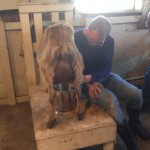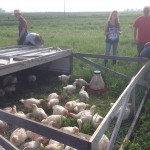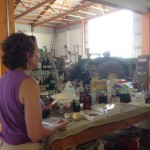Today, we got to experience some of the true marks of being a farmer: rising before the sun and witnessing the death of a farm animal. We began the morning by leaving the house at 6:00 in the morning to travel to milk goats at the Cory Family Farm, run by Tom and Mary Cory. Devotees of the Joel Salatin approach to farming, the Corys seek to have a more holistic and sustainable approach to farming and raise grass-fed, pasture-raised, no added antibiotic and hormone poultry, sheep, goats, and cows.
Our first activity was to milk goats, and I will admit that I think I don’t have fingers fit for milking. I never achieved a strong stream, so the son had to move things along and take over, so the goat didn’t get impatient. Tom then took us to see how they raise their chickens. The chickens that were to become meat, called broilers, were kept in a coop that could be moved to any spot in the pasture. This was to keep the chickens from completely obliterating the area underneath their feet by both overfeeding and pooping everywhere. The layers, however, were also kept in “chicken mobiles” that were raised higher off the ground. The final activity was moving the sheep and cows from one pasture to another and setting an electric fence. Apparently, sheep get very used to moving from field to field and only need a loud cry of “Sheep!” to get moving. The stampede of lambs and mothers was overwhelmingly cute and almost awe-inspiring. However, we had a moment of sadness when Dr. HN and Cecily found a sick lamb. Tom told us that he had respiratory problems that may have developed into pneumonia, so we decided to bring him home to see if Tom could nurse it back to health. We placed him in the back part of the van for the way home. After a few minutes of thrashing and labored breathing, we arrived back at the farm to discover that it must have died only minutes ago. As Dr. HN, Tom, and Delona told us, “That’s part of farm life. You get sad and maybe even cry a little, but you move on.”
Another reason why we visited the Corys was because of their unique lifestyle and diet. Their goal is to have the most “natural” life possible, avoiding the overuse of antibiotics and processed foods. They largely orient their diet around three main rules, loosely based on biblical values: 1) it must have been created as a food in nature, 2) it must be consumed in the most natural, un-modified form possible, and 3) you cannot hold the food higher than God. The said it was a very “common sense” approach towards nutrition, and they, therefore, stay away from processed and non-natural foods as much as possible. Although I can’t lend much to the third rule because I’m not very religious, I can see the merits in the first two. Throughout the course, we’ve sometimes discussed how some diets are more anthropologically founded, rather than stressing specific scientific qualities. By this, I am referring to diets that seek a return to human diets as based in history before the advent of modern Western innovations in food, especially relating to processed foods. One aspect that the Corys were particularly enthusiastic about is fermented foods. Fermented foods have proven to be very high in probiotics, which are beneficial to intestinal and digestive help by incorporating new and healthier gut bacteria in the small intestine. I had never had much of a taste for pickled foods. However, after reading up on some of their highlighted dishes, including kombucha, kimchi, kefir, and other pickled vegetables, I think I may be open to trying a few more dishes. It may take a while to get used to because after consuming a heavy dose a fermented veggies, my stomach was not too happy.
- Kris milking a goat.
- They will soon be eaten.
- The great migration.
- Poor lamb. 🙁
- Mary showing her prepared tinctures and mixes.
We also visited Lincolnway Energy, an ethanol plant in Nevada, IA. Ethanol is another important and relevant corn-based product, as it is a renewable resource that can be used to offset some of our reliance on foreign oil. Ethanol is created by a fermentation and distillation process not unlike making whiskey. As compared to the biodiesel plant, I was a little more familiar with the process after touring many whiskey distilleries in Scotland. Because of Iowa’s dependence on corn and current controversies on mass corn production and sustainable agriculture, ethanol producers are yet another important actor in agricultural politics. The biggest issue that faces the ethanol industry is the proposed reduction in the Renewable Fuel Standard–the EPA-set minimum volume of renewable fuel that must be mixed in transportation fuel. Naturally, the oil lobby is the biggest proponent for the reduction and therefore the opponent of the ethanol. As Jesse, our guide, said, “When another industry takes away 10% of your market share, you would want to ensure that you get it back or at least stop them from gaining any more of your market.” However, in addition to lobbying for reductions in the RFS, some oil companies are actually buying ethanol plants, gaining back control of some of their market. Jesse left us by asking us to look at the “real” cost of oil and gas, or how much subsidies play into the oil industry’s hands and making us less willing to explore other fuel sources.
- The ethanol plant
- Lookin’ like professionals.
- A humongous drying chamber, otherwise known as a “drum dryer.”
- The massive pile of DDGS, or “dried distillers grains with solubles.” This is the co-product of the ethanol-making process and is often used for livestock feed.









